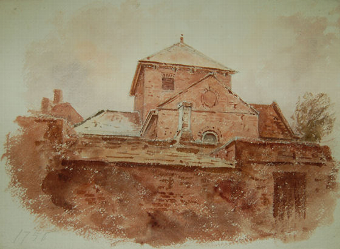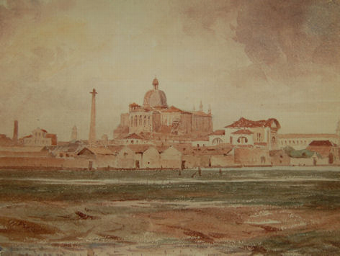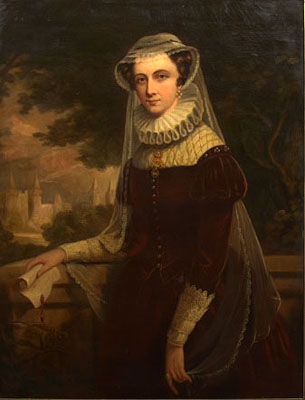featured item
near torquay, main road, devon
- View other items in:
- antiques interior design modern and vintage
- other interior design
artware ltd
Enquire about this antique
Artware Ltd has 565 antiques for sale.
click here to see them all
Torquay is a town in the unitary authority area of Torbay and ceremonial county of Devon, England. It lies 16 miles (26 km) miles south of Exeter along the A380 on the north of Torbay, 38 miles (61 km) north-east of Plymouth and adjoins the neighbouring town of Paignton on the west of the bay. Torquay?s population of 63,998 during the 2001 UK Census made it the third largest settlement in Devon. If the Torbay area, of which Torquay forms a third, were to be recognised as a city, as incumbent Torbay Mayor Nicholas Bye has proposed, it would rank as the 45th largest city in the United Kingdom with a population only slightly less than that of Brighton, which was granted city status in 2000. During the peak summer season the resort''s population swells to around 200,000 . The town''s economy was initially based upon fishing and agriculture as in the case of Brixham across Torbay, but in the early 19th century the town began to develop into a fashionable seaside resort, initially frequented by members of the Royal Navy during the Napoleonic Wars while the Royal Navy anchored in the bay and later by the cr?me de la cr?me of Victorian society as the town''s fame spread. Renowned for its healthful climate, the town earned the nickname of the English Riviera and favourable comparisons to Montpellier. Torquay was the home of the writer Agatha Christie, who lived most of her life in Torquay. The town contains an "Agatha Christie Mile", a museum dedicated to her life and work. Torquay''s name originates in it being the quay of the ancient village of Torre. In turn, Torre takes its name from the tor, the extensively quarried remains of which can be seen by the town''s Tor Hill Road. The area comprising modern Torquay has been inhabited since paleolithic times. Hand axes found in Kents Cavern date to, and a maxilla fragment known as Kents Cavern 4 may be the oldest example of a modern human in Europe, dating back to 37,000?40,000 years ago. Torquay, 1811Roman soldiers are known to have visited Torquay at some point during the period when Britain was a part of the Roman Empire, leaving offerings at a curious rock formation in Kent''s Cavern, known as ''The Face''. No evidence has been found of Roman settlement in the town.
The first major building in what was to become Torquay was Torre Abbey, a Premonstratensian monastery founded in 1196. Torquay remained a minor settlement until the Napoleonic wars, when Torbay was frequently used as a sheltered anchorage by the Channel Fleet, and relatives of officers often visited Torquay. The mild climate of Torquay attracted many visitors who considered the town a convalescence retreat where they could recover from illness away from the cold winters of more Northerly or Easterly locations. The population of Torquay grew rapidly from 838 in 1801, to 11,474 in 1851. The second phase in the expansion of Torquay began when Torre railway station was opened on 18 December 1848. The improved transport connections resulted in the rapid growth of Torquay at the expense of nearby towns not on Isambard Kingdom Brunel''s railways. Torquay, 1842The more central Torquay railway station was open on 2 August 1859. After the growth of the preceding decades, Torquay was granted borough status in 1872. Previously regarded as a convalescence retreat, Torquay began to encourage healthy visitors, and 1902 saw the first advertising campaign to market Torquay to summer tourists.
For many years Torquay was regarded as a ''Spa Town''. The reason for this was the Marine Spa, located on Beacon Hill adjacent to the harbour. Originally called the ''Bath Saloons complex'', this featured an open air tide filled swimming bath. The four stone arches exist to this day. The complex was opened in 1853 after Beacon Hill headland was dynamited to make space for it. Charles Dickens was said to have made readings there. In the 1900s a ballroom was built and a new sea water filled swimming pool. The Marine Spa, also carried out various therapies such as Seaweed Baths, Needle, Doche showers, Hot and cold water baths and electric shock treatment. Bands such as Ivy Benson played at Marine Spa ballroom, and the place was regularly visited by Rt Hon Ted Heath. During World War I, military hospitals were sited in Torquay - many survivors from the Battle of Gallipoli recuperated in the town - and it was also used as a troop staging area. In September 1915 King George V and Queen Mary visited. After the war had ended, Great Western Railway launched an advertising campaign to attract tourists to Torquay, and this helped the town grow to a major South coast resort. The Strand, 1900During World War II Torquay was regarded as safer than the towns of South East England, and played host to evacuees from the London area, the town did however suffer minor bomb damage during the war, mainly from planes dumping excess loads after participating in the Plymouth Blitz. The last air raid on Torquay took place on 29 May 1944 shortly before the D-Day landings in June and in the months leading up to D-Day thousands of US Army personnel arrived in Torquay with the 3204th Quartermaster Service Company being billeted in Chelston and Cockington. During Operation Overlord more than 23,000 men of the American 4th Infantry Division would depart Torquay for Utah Beach.
The water sport events of the 1948 Summer Olympics were held in Torquay, with the Olympic flame being brought from London to Torre Abbey Gardens. Although it will not host any Olympic events for the 2012 Summer Olympics, with the sailing taking place in Weymouth, Torbay is looking to host teams as a preparation camp. After World War II several private high-rise apartment blocks were constructed above the rock walk and harbour, giving the area a Monte Carlo feel. In 1971 after a tragedy the Marine Spa was demolished to make way for the ill-fated Coral Island leisure complex. This was characterised by its concrete arches on its upper most floor and sun bathing decks like those of a cruise liner. The site feature a hexagonal outdoor plunge pool, surrounded by sunbathing terraces leading down to Beacon Cove beach. Inside the building had several lounges, a restaurant and a nightclub within the arches of the ancient swimming bath. All levels were served by a hydraulic passenger lift. Coral Ilsand opened in 1977 and closed permanently in 1988. The complex was demolished in 1997, 20 years after its construction. The site remained derelict until 2002 when the Living Coasts Penguin park was built there. In the late 1980s Fleet Street was rebuilt as the Fleetwalk shopping mall, which features street level shops and an upper level shopping deck. The long curved building, which follows the street, is magnolia coloured and in mock Victorian style. In the late 1990s and early 2000s many new pubs and night clubs opened around the harbour area, leading to an increase in binge drinking , however in recent years a better police presence and responsible drinks promotions have improved the situation . Since World War II, the nature of tourism in the United Kingdom has changed significantly. Increasing wealth has meant that holidays abroad are now commonplace, and coastal towns are now more popular for short stays as part of a touring holiday. Recently[when?] Torquay has seen an increase in foreign visitors, and is now a major destination for foreign exchange students.
The various regions that make up the town of Torquay and their approximate extentTorquay is situated on the South West coast of England, forming one third of Torbay, and is primarily on the western side of the bay. It has a mild microclimate, often receiving among the highest hours of sunlight per day in the United Kingdom, winters in the town tend to be mild and wet with above average temperatures. Cabbage trees, also nicknamed ''Torbay Palms'' are a notable feature of the area, the trees were introduced into the area in 1820 from New Zealand and since then have flourished, There are currently thousands throughout the town and they contribute significantly to the more Mediterranean than English feel the town has. The town is made up of a number of regions that over the years amalgamated into the town of Torquay. The town''s historic core consists of the regions of Tormohun, Wellswood, The Warberries, Upton and Ellacombe and is based upon what was once the holdings of the Palk family. In 1900 the regions of Chelston and Livermead, previously part of the Cockington estate owned by the Mallocks were annexed by the town and this was swiftly followed by the absorption of the former borough of Saint Marychuch into the town. In this period Saint Marychurch consisted of more than just present day Saint Marychurch but also the regions of Plainmoor, Watcombe and Babbacombe. Finally in 1928 the Mallocks'' last holdings in Cockington were integrated within the town borders. Torquay continued to expand throughout the century leading to the development of Shiphay, Hele Village, Barton and most recently from the 1990s until present day, The Willows giving the town its current layout. Aerial view of Torquay HarbourThe most exclusive areas are the Warberries located on Warberry hill, Wellswood, The Lincombes and Ilsham Marine Drive. Despite being in an urban area, these areas have a countryside feel with a huge abundance of evergreen trees and shurbs. With the exception of the newer Ilsham Marine drive, these areas were built up by wealthy Victorians. Influenced by their travels around the Mediterranean, They built large villas with Italianate features and towers. In these areas the abundance of evergreen shrubs and trees gives the area an exotic feel even in mid winter. There are many pine trees and very many Bay Laurus nobilis bushes and trees, a variety palm trees and Phormiums. The soil type is alkaline well drained and gritty, which is ideal for Mediterranean plants and herbs. Indeed many of the villas and some streets have Italian names. There are also some high rise private apartment blocks in this area of town, but their dominance is significantly reduced by the hilly tree laden nature of the area. Ilsham Marine Drive area was built during the 1960s and 70s. The exclusive houses here have great sea views.
Antiques.co.uk Ref: 4DEENQGG
- Materials:
- Oil on Canvas
Artware Ltd
Artware Fine Art specialises in fine antique, decorative and historical portraits and topographical pictures . We cover a period from the 17th and 18th centuries through to the 19th & 20th Centuries. We have over 150 portraits in stock, which can be viewed on our web site, each historical portrait has well researched biographical information both on the sitter and the artist.
Contact details
18 La gare
51 Surrey row
London
Greater London
SE1 0BZ
UNITED KINGDOM
T: 0207 921 97904
E: greg@artwarefineart.com
W: www.artwarefineart.com












